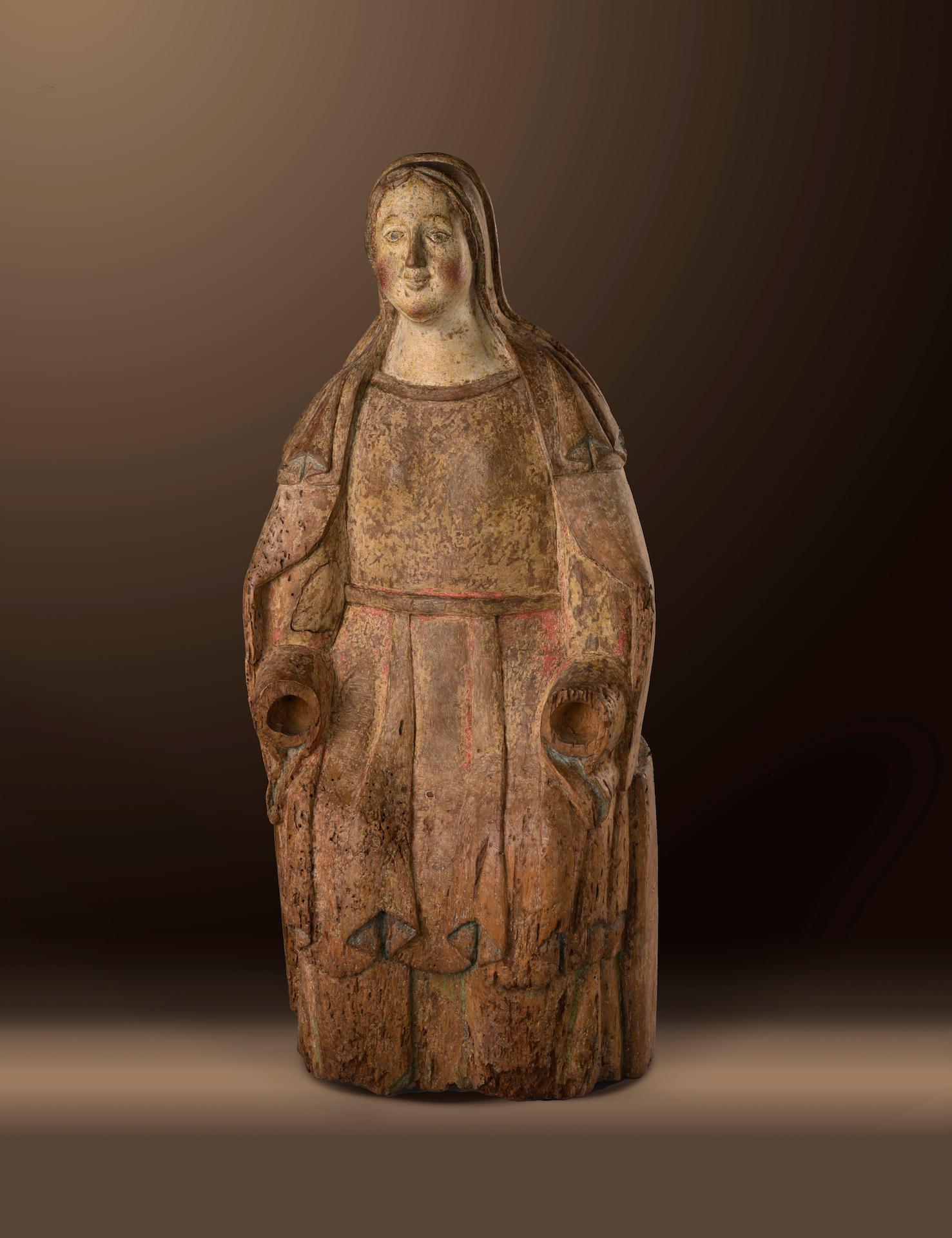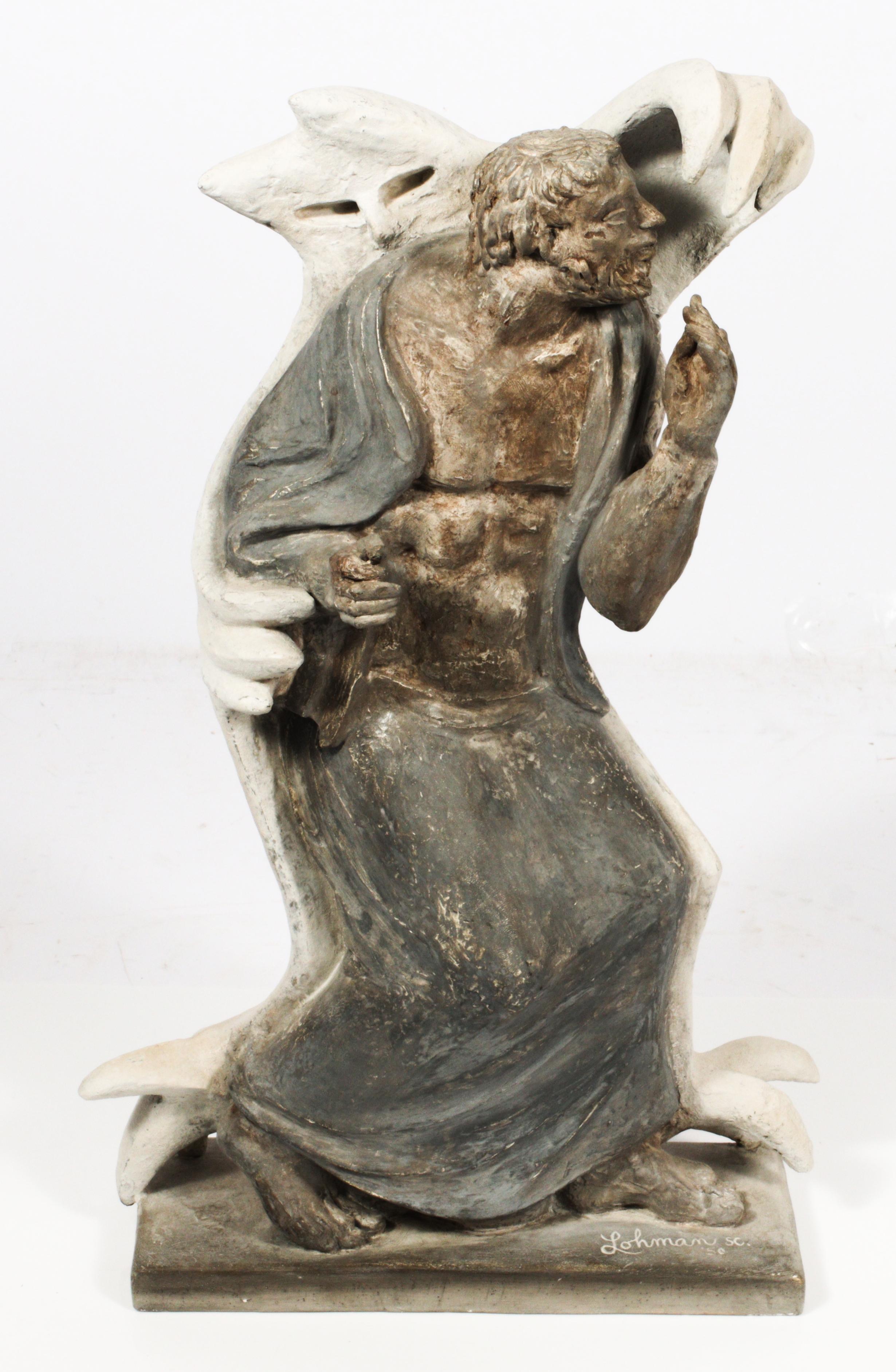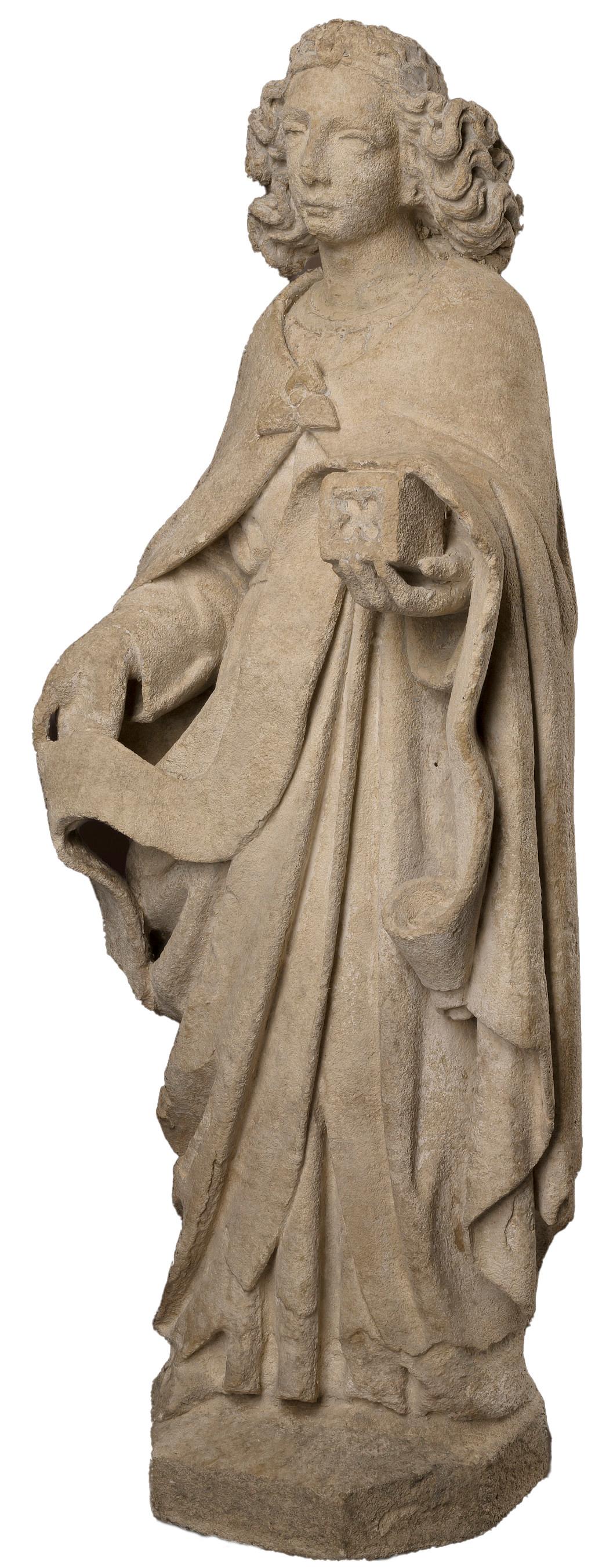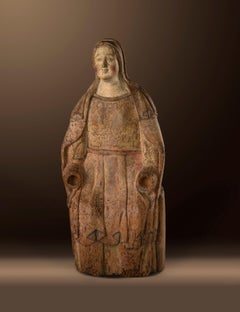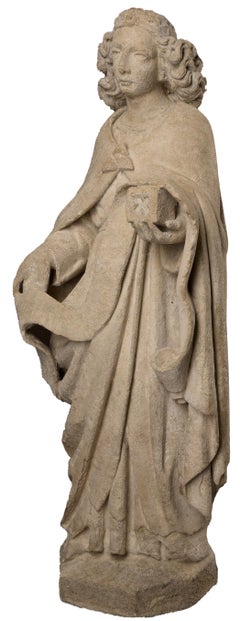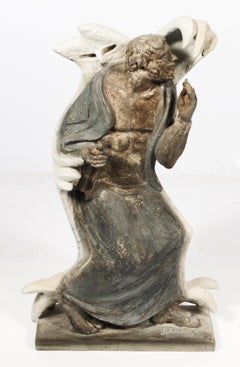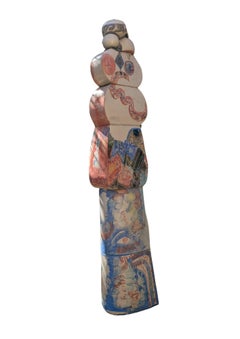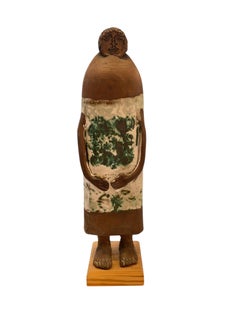Want more images or videos?
Request additional images or videos from the seller
1 of 11
UnknownHl. Hieronymus1500/20
1500/20
$28,800
£21,954.15
€25,080.91
CA$40,525.66
A$44,388.16
CHF 23,370.37
MX$529,757.97
NOK 297,834.45
SEK 272,265.58
DKK 187,421.82
About the Item
St. Jerome
347 Stridon, Croatia - 420 Bethlehem
Around 1500/20
Limestone
Remains of the original polychromy
Height 45 cm
The man with the holy name!
347 Stridon, Croation – 420 Bethlehem
Everyone knows St. Jerome, one of the most important church fathers of antiquity.
That Jerome means “Holy Name” and that he was one of the most prolific authors of Late Antiquity
was, is hardly known. His biography reads like an exciting narrative.
Jerome is one of the most captivating figures of Christian antiquity. He possessed an almost morbid sensibility, a loving and passionate heart, was jealous, suspicious, excitable, vindictive, and intemperate in his polemics. But he was also passionate in his love for the Church and in defense of Catholic truth. He united in himself the ascetic and the scholar. With Augustine, Jerome is the most learned of the Latin Church Fathers .
In addition to his grammatical and rhetorical education, Jerome possessed a knowledge of languages (Latin, Greek, Hebrew) that was unique for that time, as well as geographical, archaeological and literary knowledge. He had recognized the value of original texts and his achievement as a translator is extraordinary. His main merit for the Church remains the creation of the Vulgate (translation of the Bible). His influence on the culture of the Middle Ages was deep and lasting.
He is patron of:
Croatia, Dalmatia and Lyon,
of pupils, students, teachers, scholars, theologians, translators, proofreaders,
of the theological faculties, scientific associations, Bible societies and ascetics, against eye diseases
The representations of Jerome are still very much in demand today. Two-dimensional as a painting is this in the 15. and 16. to be found more often. As a three-dimensional sculpture rarer. This extraordinary sculpture of St. Hieronymus convinces with a high artistic quality. It was executed in limestone by a master craftsman. Remnants of polychromy are still present.
The condition is very good and according to the age museum. Such great works are special rarities today and hard to find.
- Creation Year:1500/20
- Dimensions:Height: 17.72 in (45 cm)Width: 7.88 in (20 cm)
- Medium:
- Period:
- Condition:
- Gallery Location:Wien, AT
- Reference Number:1stDibs: LU1143213902252
About the Seller
No Reviews Yet
Vetted Professional Seller
Every seller passes strict standards for authenticity and reliability
Established in 1986
1stDibs seller since 2019
- ShippingRetrieving quote...Shipping from: Wien, Austria
- Return Policy
More From This Seller
View AllMaster Angel
Located in Wien, Wien
MASTER ANGEL
Museum sculpture of the master of Mauer
Austrian Danube Region
Around 1500/20
Lime wood, carved full round
Height 55 cm
Provenance:
Hofstätter Collection, Vienna
The masterful sculpture was made in the workshop of the master of the altar of Mauer around 1500 in Lower Austria. It can be located in the context of the Danube school of the first third of the 16th century, was carved from limewood and is 55 cm tall. Since there are no attributes or context, it is an unknown figure of a carved altar.
The master of the altar of Mauer is an anonymous Gothic carver who was active between 1500 and 1525 and received this so-called emergency name through the altar for the parish and pilgrimage church of Mauer near Melk. This winged altar was probably commissioned by Göttweig Abbey in the 1470s and is made of lime wood. It shows an expression in the transition from late Gothic to early Renaissance and is considered the most important carved altar in Lower Austria, created between 1510-15.
The figure presented here is very related in its design to the figures of the altar of Mauer. In lively-moving form, the male figure turns his upper body to the right, with his head pointing upward, probably toward the sky. The right leg in lunge emerges from under the frock...
Category
16th Century Figurative Sculptures
Materials
Wood
Apostel group
Located in Wien, Wien
APOSTLE GROUP
ORIGINAL VERSION
Flemish/Brabant
Around 1500
Oak wood carved
Height 37.5 cm, width 12 cm,
Depth 12.5 cm
Category
15th Century and Earlier Figurative Sculptures
Materials
Wood
$19,800
Sedes Sapientiae
Located in Wien, Wien
Sedes Sapientiae
Pustertal um 1220/30
Weichholz/Lindenholz(?)geschnitzt
Reste von originaler Polychromie
Höhe 57 cm
Category
15th Century and Earlier Figurative Sculptures
Materials
Wood
Standing Engel
Located in Wien, Wien
Standing angel with banner
Flemish
Around 1450/60
Sandstone
60 x 21 x 15 cm
This museum figurine shows a standing angel with a banner in his right hand and a small box in his left. The youthful, ageless figure wears a coat held together with a triangular, floral brooch in front of the chest over a long robe. The angel’s gaze is directed forward, his head tilted slightly to the left. The elongated face is sculpted: the large almond-shaped eyes with accentuated upper and lower eyelids are alertly open and sharp eyebrows lead directly into the root of the nose. The straight nose above the pronounced mouth completes the idealized oval face of the angel and his calm, internalized facial expression. What is particularly remarkable, however, is the magnificent curls, which are only partially tamed by a simple headband. As if puffed up by the wind, the hair, which is sometimes streaked in parallel, sometimes wildly twisted and richly curled, stands out dynamically from the ears. The tilted head with these sideways protruding waves of hair thus conveys an immediate impression of movement. The physicality of the sculpture is expressed particularly through this organic, lifelike movement of the loosened hair.
The lively overall impression of the figure is further enhanced by the multiple rolled banners that the angel presents to the viewer. The outstretched palm of the right hand appears both intimate and confidential as well as mystically revealing. This banderole winds in gentle curves in front of the figure’s body, throws a fold over the second attribute in the angel’s left hand and falls downwards in a loose manner. The volute-shaped rolled up end of the banner clearly shows the fine texture of the banner and at the same time draws the viewer’s attention to the small cube-shaped box that the angel is holding in its slender, long-limbed fingers. The cube is decorated with a Gothic quatrefoil motif, which is often seen in the architectural tracery of windows, but was also often used to decorate caskets and other small treasures. The sweeping gestures in the presentation of the attributes suggest three-dimensionality, in contrast to the tubular folds at the base of the neck and the intricate draperies in flat and multiple overlapping garment sections. The soft curves of the folds give the impression that the clothing is made of a heavy fabric that falls diagonally down the front and is laid in several bowl folds under the right hand.
Overall, the sculptural work testifies to the highest artistic skill, which emphasizes the virtuosity of sculpture in its precious and representative overall impression. The memorable characteristics recognizable here can be seen in comparable pictorial works from Utrecht around the middle of the 15th century, when sculptural art – especially stone sculpture – was characterized by a remarkably high quality. Particularly noteworthy is the accentuated Utrecht head type with an elongated oval face, almond-shaped eyes with heavy lids and dense, vividly protruding tufts of hair framing the head. For example, the figure is comparable to a capital of an angel on the east side of the rood screen of the Joriskerk in Amersfoort (province of Utrecht) from the second quarter of the 15th century. Not only the physiognomy and hair, which in the comparative example stand somewhat more horizontally to one side, but also the garment puff above the girdle are similar. Even more related motifs, such as the cleverly placed bowl folds, can be found on the limestone figure...
Category
15th Century and Earlier Figurative Sculptures
Materials
Sandstone
Madonna
Located in Wien, Wien
MUSEUM SCULPTURE
Master workshop
Hans Klocker
before 1474, possibly in Gais -
After 1500
"CRESCENT MOON"
Around 1480/90
Stone pine wood carved
Original version
Height 77 cm
This ext...
Category
15th Century and Earlier Figurative Sculptures
Materials
Wood
Price Upon Request
Apotropäische Teufelsfigur
Located in Wien, Wien
APOTROPAIC DEVIL FIGURE
Romansh
South Tyrol or Grisons
Around 1120/50
Carved pine wood
Original version
Height 151 cm
This singular figure is a demonic, devil-like figure carved fro...
Category
15th Century and Earlier Figurative Sculptures
Materials
Wood
You May Also Like
Important Sculpture
Located in ROUEN, FR
"Important Sculpture
IMPORTANT SCULPTURE representing Saint Floran de Lorch in polychrome wood in its beautiful old polychromy. He is represented ...
Category
16th Century Figurative Sculptures
Materials
Wood
$8,064
Haunted
By Robert Lohman
Located in Indianapolis, IN
Signed and dated on base.
Lohman studied at John Herron Art Institute, and Cranbrook and Yale for graduate work. Assisted Carl Milles at Cranbrook Academy before becoming Director o...
Category
Mid-20th Century Figurative Sculptures
Materials
Plaster, Pigment
Sculpture monumentale
Located in PARIS, FR
Sublime monumental sculpture by French ceramic artist Gilbert Portanier.
The different pieces can be disassembled and packed separately for transport.
Category
20th Century Abstract Sculptures
Materials
Ceramic
Sculpture
Located in PARIS, FR
A vertical ceramic figure, rendered in a refined and monolithic style.
Category
20th Century Modern Figurative Sculptures
Materials
Ceramic
Life-Sized, Abstract Figurative Sculpture
Located in Los Angeles, CA
Remarkable, large, hand-carved, tribal-type, teak sculpture of an abstract, female form featuring a mix of refined and rough finishes.
Category
1920s Figurative Sculptures
Materials
Wood
Angel
By Bruno Lucchesi
Located in Greenwich, CT
Unique bronze sculpture of an angel
Category
20th Century Figurative Sculptures
Materials
Bronze
More Ways To Browse
Limestone Art
Black Limestone
Antique Black Limestone
Pippin Drysdale
Puffin Bronze
Renee Sintenis
Richard Macdonald Doves
Salamanca Mexico
Salvador Dali Relief
Samuel Salcedo
Shray Bronze Sculpture
Statue Of Liberty Bronze
Sylwia Jakubowska
Takashi Murakami Plush
Thomas Crawford
Tokidoki X Karl Lagerfeld
Used Walkman Cassette Player
Venus Alva Studios


